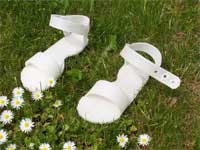A Bath University academic, who is overseeing a global effort to develop an open-source machine that ‘prints’ three-dimensional objects, is celebrating after the prototype machine succeeded in making a set of most of its own parts.
The so-called RepRap machine is a replicating rapid-prototyper that uses an ‘additive fabrication’ technique to print parts. The machine works like a printer, but, rather than squirting ink onto paper, it puts down thin layers of molten plastic which solidify. These layers are then built up to make useful 3D objects.
RepRap has, so far, been capable of making everyday plastic goods such as door handles, sandals and coat hooks. Now, the machine has also succeeded in copying most of its own 3D-printed parts.
The parts have been printed and assembled by RepRap team member, Vik Olliver, in Auckland, New Zealand, into a new RepRap machine that can replicate the same set of parts for yet another RepRap machine. While 3D printers have been available commercially for about 25 years, RepRap is the first that can essentially print itself.
The RepRap research and development project was conceived, and is directed, by Dr Adrian Bowyer, a senior lecturer in engineering in the Faculty of Engineering and Design at Bath University.
'These days, most people in the developed world run a professional-quality print works, photographic lab and CD-pressing plant in their own house, all courtesy of their home PC. Why shouldn't they also run their own desktop factory capable of making many of the things they presently buy in shops, too?' asked Dr Bowyer.

Adrian Bowyer (left) and Vik Olliver (right) with a parent RepRap machine, made on a conventional rapid prototyper, and the first complete working child RepRap machine, made by the RepRap on the left
'The possibilities are endless. Now, people can make exactly what they want. If the design of an existing object does not quite suit their needs, they can easily redesign it on their PC and print that out, instead of making do with a mass-produced second-best design from the shops.'
Complete plans for the prototype RepRap 3D printer and detailed tutorials to aid motivated amateurs (and professionals) in assembling one are available, free-of-charge, at the RepRap website.
The materials, plus the minority of parts that the machine cannot print, cost about £300. All those non-printed parts can be bought at hardware shops or from online stores.




April 1886: the Brunkebergs tunnel
First ever example of a ground source heat pump?